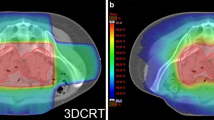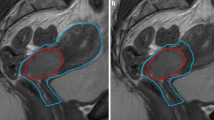Purpose:
Reduction of irradiated small bowel volume, using a conformal three-dimensional treatment planning technique in postoperative radiotherapy of cervical cancer patients. Patients and Methods: Large gynecological treatment fields including the para-aortic nodes were analyzed in 15 patients. A conventional treatment plan with anterior and posterior (AP-PA) parallel opposed fields and a 3D 4-field conformal radiotherapy plan with a central blocking of small bowel were compared for each patient. Dose-volume histograms and dose parameters were established. Because of the tolerance constraints of the small bowel, the cumulative dose applied to the target was 48.6 Gy. Results: The mean Tumor Control Probability (TCP) values for both the conventional and the conformal technique were 0.60 and 0.61, respectively, with ranges of 0.56 to 0.67 and 0.57 to 0.66, respectively. The mean volume receiving 95% or more of the prescribed dose (V95) of the small bowel was 47.6% (32.5 to 66.3%) in the AP-PA technique and 14.9% (7.0 to 22.5%) in the conformal technique (p < 0.001), indicating a significant reduction in irradiated volume of small bowel in the higher dose range. The mean Normal Tissue Complication Probability (NTCP) decreased from 0.11 to 0.03 with the conformal plan. In patients who received a pedicled omentoplasty during surgery, the mean V95 for small bowel could be reduced to 8.5% (7.0 to 9.9%). The mean median dose to the kidneys was only slightly elevated in the conformal treatment. Especially the mean dose to the right kidney in conventional vs conformal treatment was 3.3 vs 7.9 Gy. The mean near-minimum dose (D95) to the rectosigmoid decreased from 48.4 to 30.1 Gy in the conformal plan compared to the conventional plan. Conclusion: The small bowel dose can be significantly reduced with 3D treatment planning, particularly if a pedicled omentoplasty is performed. This allows dose escalation to the tumor region without unacceptable toxicity for the small bowel.
Hintergrund:
Reduktion des Volumens des Dünndarms durch Anwendung einer dreidimensionalen Bestrahlungsplanung bei der postoperativen Bestrahlung von Zervixkarzinomen. Patienten und Methode: Große gynäkologische Bestrahlungsfelder, einschließlich der paraaortalen Region, wurden bei 15 Patientinnen analysiert. Ein konventioneller Bestrahlungsplan mit zwei parallel opponierenden Feldern und eine 3D-Konformationsbestrahlungstechnik mit vier Feldern und zentraler Abschirmung des Dünndarms wurden für jede Patientin verglichen. Dosisparameter und Dosisvolumenhistogramme wurden ermittelt und verglichen. Infolge der Einschränkung der Dosen für den Dünndarm betrug die kumulative Dosis für das Zielvolumen 48,6 Gy. Ergebnisse: Die durchschnittlichen Tumorkontrollwahrscheinlichkeitswerte (TKW-Werte) für die konventionelle und die Konformationstechnik betrugen 0,60 und 0,61, mit Streuung von 0,56 bis 0,67 bzw. 0,57 bis 0,66. Das mittlere Volumen des Dünndarms, das 95% oder mehr der verschriebenen Dosen (V95) erhielt, betrug 47,6% (32,5 bis 66,3%) in der konventionellen Technik und 14,9% (7,0 bis 22,5%) in der Konformationstechnik (p < 0,001), eine signifikante Reduktion im bestrahlten Dünndarmvolumen im höheren Dosisniveau. Die mittlere Wahrscheinlichkeit einer Normalgewebekomplikation (NKW) war im Konformationsbestrahlungsplan von 0,11 auf 0,03 reduziert. Bei Patientinnen, die während der Operation eine Omentoplastik erhielten, konnte das mittlere V95 für den Dünndarm auf 8,5% (7,0 bis 9,9%) reduziert werden. Die Mediandosis für die Nieren war in der Konformationstechnik nur etwas erhöht. Vor allem der Unterschied in der mittleren Dosis für die rechte Niere betrug im konventionellen Plan gegenüber dem Konformationsplan 3,3 vs. 7,9 Gy. Die mittlere Dosis für das Rektosigmoid, die 95% des Volumens oder mehr erreicht (D95), war im Konformationsplan in Vergleich zum konventionellen Plan von 48,4 auf 30,1 Gy reduziert. Schlußfolgerung: Die Dosis für den Dünndarm wurde mit der 3D-Bestrahlungsplanung signifikant reduziert, besonders wenn während der Operation eine Omentoplastik durchgeführt wurde. Dies kann die Möglichkeiten für Dosiseskalation für die Tumorregion vergrößern ohne unakzeptable Nebenwirkungen auf den Dünndarm.
Similar content being viewed by others
Author information
Authors and Affiliations
Additional information
Submitted: 15 Mar 1999. Accepted: 7 June 1999.
Rights and permissions
About this article
Cite this article
Olofsen-van Acht, M., Quint, S., Seven, M. et al. Three-Dimensional Treatment Planning for Postoperative Radiotherapy in Patients with Node-Positive Cervical Cancer Comparison between a Conventional and a Conformal Technique. Strahlenther Onkol 175, 462–469 (1999). https://doi.org/10.1007/s000660050037
Published:
Issue Date:
DOI: https://doi.org/10.1007/s000660050037




